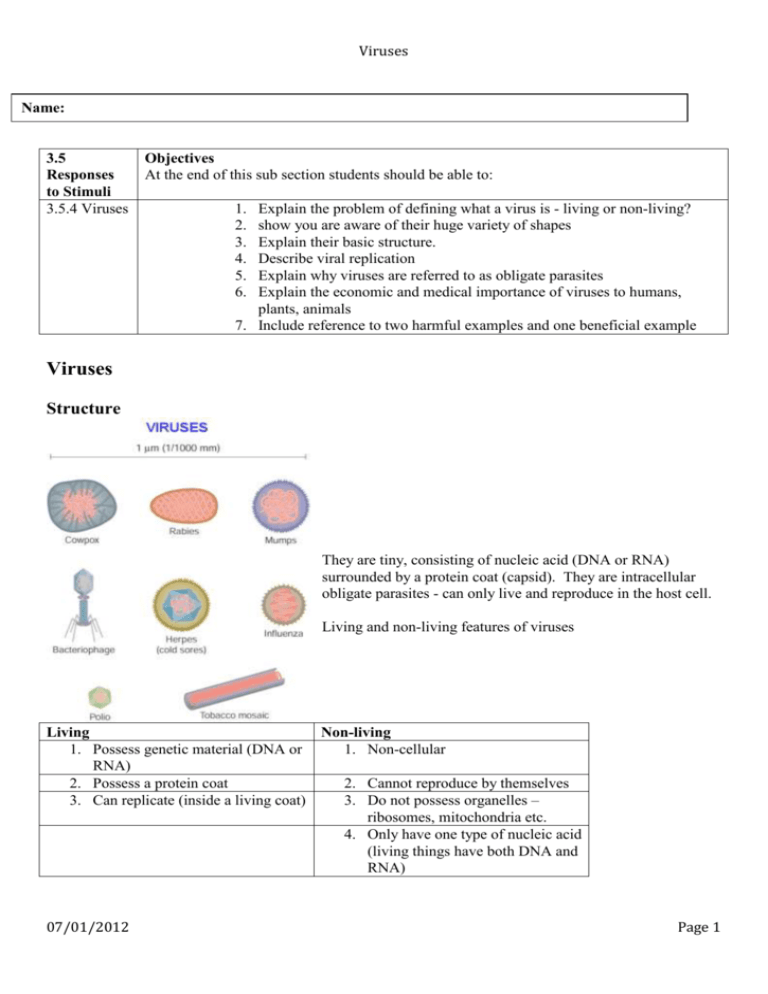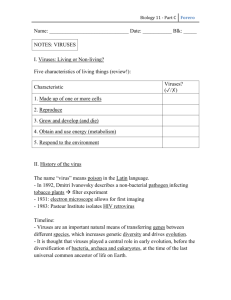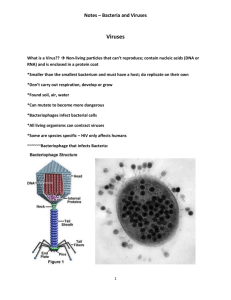Economic effects of viruses - Mrs. Barrett`s Biology Site
advertisement

Viruses Name: 3.5 Responses to Stimuli 3.5.4 Viruses Objectives At the end of this sub section students should be able to: 1. 2. 3. 4. 5. 6. Explain the problem of defining what a virus is - living or non-living? show you are aware of their huge variety of shapes Explain their basic structure. Describe viral replication Explain why viruses are referred to as obligate parasites Explain the economic and medical importance of viruses to humans, plants, animals 7. Include reference to two harmful examples and one beneficial example Viruses Structure They are tiny, consisting of nucleic acid (DNA or RNA) surrounded by a protein coat (capsid). They are intracellular obligate parasites - can only live and reproduce in the host cell. Living and non-living features of viruses Living Non-living 1. Possess genetic material (DNA or 1. Non-cellular RNA) 2. Possess a protein coat 2. Cannot reproduce by themselves 3. Can replicate (inside a living coat) 3. Do not possess organelles – ribosomes, mitochondria etc. 4. Only have one type of nucleic acid (living things have both DNA and RNA) 07/01/2012 Page 1 Viruses Shapes – Helical (rod-shaped)– the proteins in the capsid are arranged in a helix or spiral e.g. tobacco mosaic virus. Polyhedral(spherical) – the protein coat is arranged into many sides or faces e.g. polio, herpes, and influenza viruses. Complex - a combination of helical and polyhedral parts e.g. bacteriophage, HIV, rabies, smallpox viruses. Replication of a bacteriophage – a virus that infects bacteria. Attachment A virus attaches to host cell. Proteins on the virus match up with receptor sites on the host wall or membrane. This is why viruses are often specific to one host. Entry The virus forms a hole in the host cell and the viral nucleic acid is squeezed out of its protein coat into the host cell. Protein coat is left outside cell. In animal cells the protein coats also enter, but are digested. Synthesis The host nucleic acid is made inactive. The viral nucleic acid uses the host’s organelles to produce new viral nucleic acid and protein coats. Assembly New viruses are assembled inside the host cell. Release The new viruses are released by lysis. The new viruses use enzymes to burst out of host cell. Retroviruses contain RNA and the enzyme reverse transcriptase that converts the virus RNA to DNA. This DNA then makes new copies of the virus RNA and new viruses inside host e.g. HIV virus. Some viruses do not destroy the host DNA. Instead the viral DNA may be inserted into the host DNA and then passed on from one cell to the next when replication takes place. The viral DNA may remain dormant in these lysogenic cells or become active again, making more copies of itself and lysing the host cell e.g. diphtheria, scarlet fever and botulism. The virus, once integrated, causes the bacterium to release toxins, which cause the disease. 07/01/2012 Page 2 Viruses Economic effects of viruses Study two harmful and one beneficial. Disadvantages Cause disease/death to humans or damaging food crops or animals. Ill people cannot work and need to be cared for. Diseases caused by viruses: Human: DNA viruses – smallpox, chicken pox, shingles, warts, verrucas (direct physical contact with contaminated surfaces), hepatitis B. RNA viruses - common cold, influenza, mumps, measles (all spread by droplet infection), polio (droplets/faeces),German measles, rabies (from a bite of an infected dog), Hepatitis A, Ebola, AIDS. Plant: tobacco mosaic virus (gives tobacco plant a spotted, mosaic appearance), potato mosaic virus and sugar beet virus Most plant viruses are transmitted by insects (vectors) e.g. greenfly, which suck sap. Animal: cowpox, foot and mouth (in cattle and sheep), rabies (affects nervous system of dogs mainly), distemper (dogs, fatal for puppies unless immunised), Newcastle disease in poultry and swine fever in pigs. AIDS - Acquired Immune Deficiency Syndrome Virus nature HIV (human immunodeficiency virus) is a retrovirus. Effects HIV virus attacks helper T-lymphocytes upon which we are dependent for our immune system (and so can’t produce antibodies to pathogens or to organisms that don’t normally cause medical problems i.e. opportunistic infections e.g. pneumonia). Transmission - by body fluids e.g. blood, semen, saliva. It can also be passed from mother to child across placenta or in breast milk. High-risk groups = Receivers of blood transfusions, intravenous drug users (via contaminated needles), haemophiliacs receiving blood products and those with multiple sexual partners. Diagnosis Blood tests of HIV positive people will reveal the presence of antibodies. Some HIV+ will get rid of the virus and so are immune but for others the virus is dormant and may turn into full-blown AIDS at any stage. Control and prevention: At present no cure and no vaccine due to rapid mutation of virus. Methods of prevention: 1. Avoid unknown or multiple sexual partners. 2. Do not share needles, toothbrushes, razors etc.. 07/01/2012 Page 3 Viruses 3. 4. 6. 7. Only use screened blood products. Use condoms if partner’s status unknown. Avoid contact (use gloves) with blood/body fluids/wounds. Don’t donate blood, semen or body organs if have AIDS or tested positive for the antibodies. Statistics: Approx. 150 million people worldwide suffer from AIDS. Number growing by 20%, every year, especially in developing countries. ‘Cold sores’: arises from ‘herpes simplex’ virus, found in nerve endings near surface of skin being activated by e.g. UV light or stress. Transmission: direct physical contact. BSE and CJD Prions are infectious agents, made of protein and are smaller than viruses. The genes that code for these altered proteins are present in normal and infected individuals. In BSE (Bovine Spongiform Encephalopathy) – mad cow disease – the prions had triggered a change in the normal proteins in the animals’ nerves. Result was spongy holes and waxy deposits in their brains. Cause = cattle feed made from ground-up tissues of sheep that had scrapies (also prion-caused). Use of sheep tissues in feed banned in 1988. Prions also involved in the human form of the disease, vCJD (variant Creutzfeldt-Jakob Disease). In Ireland, we were exposed to contaminated beef in 1980-1990. Symptoms, which include loss of vision and speech, rapid mental deterioration and paralysis may take 10-20 years to develop. Advantages of viruses 1. Control of infections Bacteriophages can be used to kill harmful bacteria. In this way they may help reduce infections by antibiotic resistance bacteria. bacteriophage attack the harmful E. coli. 2. Genetic engineering Used as vectors in to transfer genes from one organism to another (e.g. a new valuable protein). Viruses can be cultured in living tissues. Retroviruses produce the enzyme reverse transcriptase, which is used for the cutting of DNA molecules in genetic engineering and the production of DNA profiles. 3. Myxomatosis (biological control) virus was used to control rabbit population in Australia (but now rabbit population increasing due to resistance to virus). Immunity against viruses 1. Natural Body’s general defense system e.g. skin, mucus, stomach acid, phagocytes etc. Specific defense system - body produces antibodies to antigen (found in protein coat of virus). 2. Artificial 07/01/2012 Page 4 Viruses Vaccination: Using an attenuated (weakened) form of virus e.g. yellow fever virus or a similar but harmless strain e.g. smallpox vaccine. Injecting antibodies. 3. Viruses do not respond to antibiotics. Some antiviral drugs exist. Interferon: is a range of substances produced by virus-infected cells to protect healthy cells. It can be made artificially and can help to treat colds and viral hepatitis B. ACV (Acyclovir) helps to treat herpes (cold sore) virus – interferes with viral replication. AZT (Azidothymidine) has had some success in slowing the development of AIDS. 07/01/2012 Page 5







